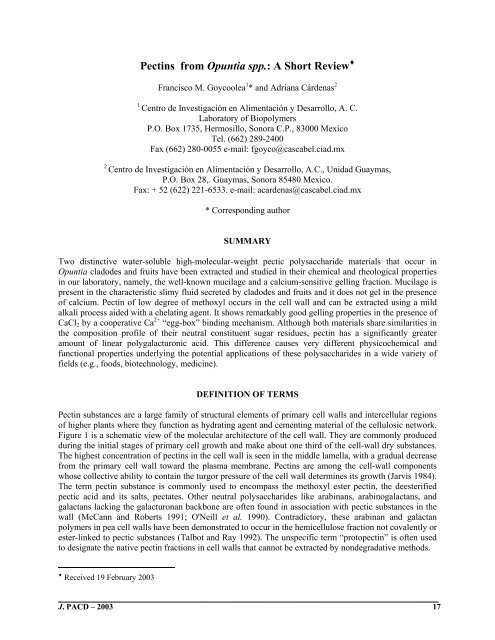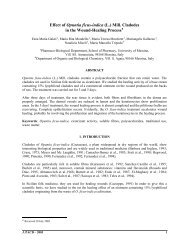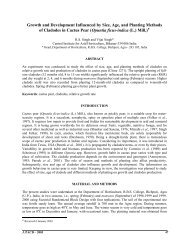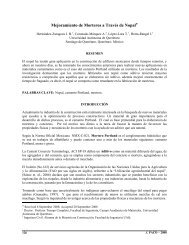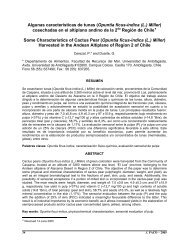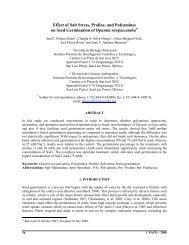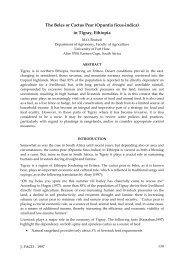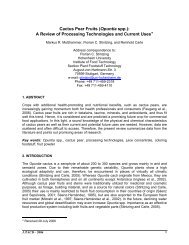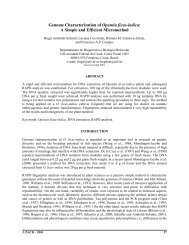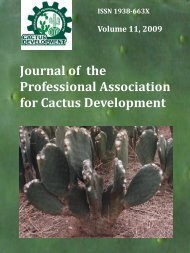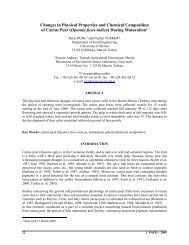Pectins from Opuntia spp.: A Short Review
Pectins from Opuntia spp.: A Short Review
Pectins from Opuntia spp.: A Short Review
You also want an ePaper? Increase the reach of your titles
YUMPU automatically turns print PDFs into web optimized ePapers that Google loves.
<strong>Pectins</strong> <strong>from</strong> <strong>Opuntia</strong> <strong>spp</strong>.: A <strong>Short</strong> <strong>Review</strong> ♦Francisco M. Goycoolea 1 * and Adriana Cárdenas 21Centro de Investigación en Alimentación y Desarrollo, A. C.Laboratory of BiopolymersP.O. Box 1735, Hermosillo, Sonora C.P., 83000 MexicoTel. (662) 289-2400Fax (662) 280-0055 e-mail: fgoyco@cascabel.ciad.mx2Centro de Investigación en Alimentación y Desarrollo, A.C., Unidad Guaymas,P.O. Box 28,. Guaymas, Sonora 85480 Mexico.Fax: + 52 (622) 221-6533. e-mail: acardenas@cascabel.ciad.mx* Corresponding authorSUMMARYTwo distinctive water-soluble high-molecular-weight pectic polysaccharide materials that occur in<strong>Opuntia</strong> cladodes and fruits have been extracted and studied in their chemical and rheological propertiesin our laboratory, namely, the well-known mucilage and a calcium-sensitive gelling fraction. Mucilage ispresent in the characteristic slimy fluid secreted by cladodes and fruits and it does not gel in the presenceof calcium. Pectin of low degree of methoxyl occurs in the cell wall and can be extracted using a mildalkali process aided with a chelating agent. It shows remarkably good gelling properties in the presence ofCaCl 2 by a cooperative Ca 2+ “egg-box” binding mechanism. Although both materials share similarities inthe composition profile of their neutral constituent sugar residues, pectin has a significantly greateramount of linear polygalacturonic acid. This difference causes very different physicochemical andfunctional properties underlying the potential applications of these polysaccharides in a wide variety offields (e.g., foods, biotechnology, medicine).DEFINITION OF TERMSPectin substances are a large family of structural elements of primary cell walls and intercellular regionsof higher plants where they function as hydrating agent and cementing material of the cellulosic network.Figure 1 is a schematic view of the molecular architecture of the cell wall. They are commonly producedduring the initial stages of primary cell growth and make about one third of the cell-wall dry substances.The highest concentration of pectins in the cell wall is seen in the middle lamella, with a gradual decrease<strong>from</strong> the primary cell wall toward the plasma membrane. <strong>Pectins</strong> are among the cell-wall componentswhose collective ability to contain the turgor pressure of the cell wall determines its growth (Jarvis 1984).The term pectin substance is commonly used to encompass the methoxyl ester pectin, the deesterifiedpectic acid and its salts, pectates. Other neutral polysaccharides like arabinans, arabinogalactans, andgalactans lacking the galacturonan backbone are often found in association with pectic substances in thewall (McCann and Roberts 1991; O'Neill et al. 1990). Contradictory, these arabinan and galactanpolymers in pea cell walls have been demonstrated to occur in the hemicellulose fraction not covalently orester-linked to pectic substances (Talbot and Ray 1992). The unspecific term “protopectin” is often usedto designate the native pectin fractions in cell walls that cannot be extracted by nondegradative methods.♦ Received 19 February 2003J. PACD – 2003 17
Figure 1. Simplified and Schematic Representation of the Architecture of the Cell Wall.Cellulose microfibrils appear crosslinked by hemicellulosic polymers. <strong>Pectins</strong> present in the middlelamella are Ca 2+ crosslinked to each other (McCann and Roberts 1991).Chemical Structure of Isolated <strong>Pectins</strong>Chemically, pectins are a family of complex heteropolysaccharides comprised by a diversity ofcarbohydrate residues. Like most other plant polysaccharides, pectins are polydisperse in composition andmolecular size, that is, they are heterogeneous with respect to both chemical structure and molecularweight. Their composition varies with the source and conditions of extraction, location, and otherenvironmental factors (Chang et al. 1994). The main component common to most pectins is a backbonechain structure of α-(1→4)-linked D-galacturonic acid units interrupted by the insertion of (1→2)-linkedL-rhamnopyranosyl residues in adjacent or alternate positions (Aspinall 1980). The amount of rhamnosein pectins is typically 1% to 4% These linear segments consisting predominantly of galacturonan arecalled homogalacturonans. The degree of polymerization (DP) of uninterrupted galacturonosyl regions inhomogalacturonan segments <strong>from</strong> apple, beet, and citrus lies in the range of 70 to 100 (Thibault et al.1993). Another important feature of galacturonans is the esterification of carboxylic groups ingalacturonic acid residues with methanol and in certain pectins, their hydroxyl groups are also partiallyacetylated. The degree of methylation (DM) is defined as the number of moles of methanol per 100 molesof galacturonic acid. <strong>Pectins</strong> are called high-methoxyl (HM) pectins when the value for DM is 50 orhigher. While when DM is below 50, the pectin is called low-methoxyl (LM) pectin. When less than 10%of the carboxyl groups are methylated, one speaks of pectic acid. The degree of acetylation (DAc) isdefined as the percentage of galacturonosyl residues esterified with one acetyl group. DAc is generallylow in native pectins, ranging between 3% and 15% (Voragen et al. 1995). The botanic origin and theextraction procedure determine the content of galacturonic acid, DM, and DAc in pectins.Other constituent sugars are attached in side chains, the most common being D-galactose, L-arabinose,and D-xylose. D-glucose, D-mannose, L-fucose, and D-glucuronic acid are found less frequently. Themajor sugars, D-galactose and L-arabinose, are present in more complex chains with structures similar tothose of arabinans and arabinogalactans and with chain lengths that can be considerably large.<strong>Pectins</strong> in <strong>Opuntia</strong> <strong>spp</strong>.The occurrence of pectins in various <strong>Opuntia</strong> species <strong>from</strong> Mexico has been documented for almost threedecades (Villarreal et al. 1963). Table 1 shows data <strong>from</strong> such early studies in which the pectin contentsfound in eight species and varieties of <strong>Opuntia</strong> were compared. The yield of soluble pectin in thesesamples was within a wide range of 0.13% to 2.64% in wet basis (1.00% to 23.87% in dry-weight basis).18 J. PACD – 2003
Attention is drawn to the high pectin content found for O. robusta (known as “nopal camueso”) incomparison with O. ficus indica and the other species. It is interesting to note that the pectin content in O.robusta is within the range reported for citrus peel (20% to 30% d.m.b.), an industrial source of pectin. Atpresent, apple pomace and citrus peels are the main sources of commercially acceptable pectins. Othersources of pectins that have been considered are sugar beet and residues <strong>from</strong> the seed heads ofsunflowers. From this comparison, it is clear that <strong>Opuntia</strong> <strong>spp</strong>. can be regarded as a promisingcommercial source of industrial pectins. Nevertheless, many other technical and economic considerationsbeside pectin content must be made carefully in order to appraise the viability of cactus pectinindustrialization.Table 1. Pectin Content in Some <strong>Opuntia</strong> Species and in Some FruitsSpeciesTotal Pectin(%)WetWeightDryWeightProtopectin(%)WetWeightDryWeightSoluble Pectin(%)WetWeightDryWeight<strong>Opuntia</strong> ficus-indica var I a 1.91 13.84 0.097 3.56 1.418 10.28O. ficus-indica var II a 1.10 8.39 0.622 4.74 0.478 3.65O. <strong>spp</strong>. (Blanca I) a 0.95 7.6 0.448 3.58 0.482 4.02O. <strong>spp</strong> (Blanca II) a 0.84 7.05 0.721 6.05 0.129 1.00O. amylacea a 1.40 9.58 0.685 4.69 0.715 4.89O. megacantha a 0.80 5.06 0.586 3.43 0.279 1.63O. steptracantha a 0.97 6.59 0.605 4.38 0.365 2.21O. robusta a 3.30 26.61 0.653 5.26 2.64 23.87Apple pomace b,c 0.5-1.6 10-15 ------ ------ ------ ------Citrus peel c ------ 20-30 ------ ------ ------ ------Sugar-beet pulp b 1.00 ------ ------ ------ ------ ------aData <strong>from</strong> (Villarreal et al. 1963)bData <strong>from</strong> (Renard and Thibault 1993)cData <strong>from</strong> (Rolin 1993)J. PACD – 2003 19
Diced cactus pads heated at 85 o C for 20 min.Neutralised to pH 7-7.5 with NaOHLiquidization and centrifugationPRECIPITATE (GE)SUPERNATANT (NE)Suspention in 50mM NaOH, containig 0.75% sodiumhexametaphospate, stir x 1hAddition of NaCl to 1MFiltration. Adjust pH of supernatant to 2 with HCl,stir for 10 min and let to precipitateCentrifugeFiltration through 3µm membraneRedispersion of the precipitate in H 2 O,Adjust pH to 8 with NaOHFiltration with 3, 1.2, 0.8and 0.45 µm membranesPrecipitation with ethanol 50% v/vCentrifugationWashing in ethanol/H 2 O mixtures (70, 80, 90, 95 y 100% v/v)Drying at room temperatureFigure 2. Laboratory-Scale Extraction Protocols for the Isolation and Purification of <strong>Pectins</strong> <strong>from</strong> <strong>Opuntia</strong>Cladodes, Namely a Gelling Extract (GE) and a Neutral Nongelling Mucilage Extract (NE)In a recent study completed in our laboratory, we succeeded in extracting a pectin with gelling capacityand a nongelling mucilage fraction <strong>from</strong> O. ficus-indica cladodes. The extraction protocol adopted for theisolation of these two distinctive pectic substances is outlined in Figure 2. The protocol included the useof a calcium-sequestering agent in alkali conditions, which ensured the best chelating performance(Cárdenas et al. 2003).The chemical composition of the gelling extract (GE) was found to be markedly different <strong>from</strong> that of themucilage material (NE extract) reported by independent groups in Mexico (Medina-Torres et al. 2000)and France (Majdoub et al. 2001). This comparison is summarized in Table 2.20 J. PACD – 2003
Table 2. Sugar Composition of <strong>Opuntia</strong> ficus-indica Pectin Extract Obtained by AlkalineProcess Aided With a Sequestering Agent and Cactus and Prickly-Pear PecticExtracts Previously Studied (% in weight)PectinGellingExtract (GE)(this work)Prickly-Pear-PeelPectin(acidprocess) aMucilagePrecipitatedinIsopropanol/Acetone cCharacteristicMucilageExtract (NE) Lyophilized(this work) Mucilage bUronic acids d 56.3 64.0 11.0 19.4 6.4Rhamnose d 0.5 0 1.75 6.9 7.0Arabinose d 5.6 6.0 17.93 33.1 44.0Galactose d 6.5 22.0 20.99 20.3 20.4Glucose d 0 2.6 0 1 0Xylose d 0.9 2.1 3.06 18.7 22.1Degree of esterification 0 ------ ------ ------ ------Intrinsic viscosity (ml/g) e 234 ------ 1050 840 ------Yield (%, p/p) 0.6 0.12 0.07 ------ ------a Data taken <strong>from</strong> (Forni et al. 1994)bData taken <strong>from</strong> (Majdoub et al. 2001)cData taken <strong>from</strong> (Medina-Torres et al. 2000)dGlucuronic + galacturonic acideDetermined in 0.1M NaCl at 20°CIn general, the neutral-sugars content of nopal pectin was lower than that reported for pectins of othersources. This, together with the low rhamnose content, may be suggestive of the existence ofregions of long chain segments of polygalacturonate (homogalacturonan), which are essential to thegelling process, as it is further discussed below. While the content of uronic acids in cactus pectincompared well with that of the tuna-peel pectin obtained by an acidic process, it was notably superior tothat of mucilage extracts which do not have a demonstrated gelling capacity in the presence of Ca 2+ . Ingeneral, the overall composition profile of the cactus pectin composition coincides well with that of pectinobtained <strong>from</strong> lemon-peel pectin (Ros et al. 1996) and sugar beet (Oosterveld et al. 2000). A negligibleDM value was analyzed in a film of the GE material using Fourier-transformed infrared spectroscopy(FTIR) (Cárdenas et al. 2003), suggestive that all esterified methyl groups were saponificated during theextraction procedure.The chemical composition of mucilage of <strong>Opuntia</strong> ficus-indica, in turn, has also long been studied usingdifferent chromatographic techniques (Amin et al. 1970; McGarvie and Parolis 1979, 1979, 1981, 1981;Trachtenberg and Mayer 1981). In general, the stems of cactus contain varying proportions of D-galactose, L-arabinose (pyranose and furanose forms), D-xylose, and L-rhamnose and as the major neutralsugar units as well as D-galacturonic acid. The suggested primary structure describes the mucilage as alinear repeating “core” chain of (1→4)-linked β-D-galacturonic acid and α(1→2)-linked L-rhamnosewith trisaccharide side chains of β(1→6)-linked D-galactose attached at O(4) of L-rhamnose residues(McGarvie and Parolis 1979, 1981, 1981). The galactose side residues present further branching in eitherO(3) or both O(3) and O(4) positions. The composition of these acid-labile peripheral chains is complex;at least 20 different types of oligosaccharides (mostly as disaccharides and trisaccharides) have beenidentified (McGarvie and Parolis 1981). These, invariably containing L-arabinose residues present as(1→5)-linked residues and possibly as branch points and single D-xylose groups, occur as end-groups, toJ. PACD – 2003 21
give a xylose-to-arabinose ratio of ∼1:2. This ratio seems to hold in close agreement with data formucilage extracts analyzed in the more recent studies of Brito and co-workers (Medina-Torres et al.2000) (xyl:ara ~1.8) and Majdoub et al. (Majdoub et al. 2001) (xyl:ara ~2.0), but not with our own extract(xyl:ara ~0.17) included in Table 2. This chemical composition shows great similarities to that of thehighly branched regions (“hairy” regions) of cell-wall pectins, particularly to the rhamnogalacturonan I(RG-I) fraction (Pellerin et al. 1996; Voragen et al. 1995). In light of this close resemblance, mucilage<strong>from</strong> <strong>Opuntia</strong> and other cacti, are indistinctly referred to as pectins. However, up to now, the mucilagepolysaccharides in <strong>Opuntia</strong>, do not seem to be chemically associated, either covalently or otherwise, tothe structural cell-wall pectins. Instead, it has been proposed that mucilage biosynthesis takes place inspecialized cells which excrete it into the apoplast where it helps to regulate the cellular water contentduring the initial phase of dehydration (Nobel et al. 1992). Its physiological role has been associated withtheir ability to bind water under unfavorable climatic conditions (Mindt et al. 1975). It has also beensuggested that the mucilage has a predominant role in the Ca 2+ economy of the plant (Trachtenberg andMayer 1981). The major characteristics of these two distinctive families of polysaccharides are reviewedin the following sections.Properties of Nopal MucilageMajdoub et al. (2001), have recently addressed the problem of trying to understand the relationshipbetween the structure and the properties of the pectin of peeled prickly pear. The material that theseauthors evaluated was the aqueous extract of macerated peeled nopals. Its composition is shown inTable 2. Two polymeric components were identified in the purified extract by size-exclusionchromatography (SEC) coupled to double detection by refractive index (RI) and multiangle laser lightscattering (MALLS) in 0.1M LiNO 3 , namely a high-molecular-weight fraction (~10% by weight) and alow-molecular-weight fraction (~90% by weight). The two populations of molecular species wereseparated satisfactorily in a different experiment by subjecting the native sample to ultrafiltration againstdeionized water during a week and using a series of membranes with a molecular weight cut-off of100,000 g mol -1 . The material retained by the membrane (HWS) had a high weight-average molar mass(M w ~14.2 × 10 6 ), while the filtrate (LWS) had a low M w ~4000. LWS comprised predominantly proteinspecies (~80% by weight), while no protein was detected in the HWS fraction. Therefore, the majorcomponents of the native mucilage extract are low-molecular-weight proteins. Although it is notexplicitly discussed in the paper of Majdoub et al. (2001), the likely reason why proteins are not removedduring the extraction is that the extract was not precipitated with ethanol (cf. Figure 2). The nature of theproteins present in nonprecipitated nopal mucilage extract is mostly unknown and <strong>from</strong> their size andpoor water solubility only inferences have been made, so that they have been compared with the 2Salbumin storage family proteins present in the seeds of O. ficus-indica (Uschoa et al. 1998). That proteinsare essentially associated only to LWS, was demonstrated by an experiment in which the native samplewas subjected to the activity of pronase. Only species in LWS were hydrolyzed, while HWSpolysaccharide fraction was not affected. The resistance of HWS to pronase activity is in contrast with thewell-known arabinogalactan protein (AGP) complex present in gum arabic, in which the protein speciesare associated to the high-molecular-weight fractions (Connolly et al. 1988). AGP macromolecularassemblies of varying molecular size in gum arabic are key to its unique functionality, namely, thecapacity to lower the oil-water interfacial tension, and hence to create the emulsifying capacity in oil-inwateremulsions (Dickinson and Galazka 1991; Dickinson et al. 1991; Ray et al. 1995). Nevertheless,proteins themselves are also known to be effective emulsifiers, hence, the potential surface activity ofnopal mucilage cannot be ruled out on these grounds. To our knowledge, the surface properties of nopalmucilage so far have not been tested.22 J. PACD – 2003
1001001010G', G" (Pa)10.1G´G"η*0.010.01 0.1 1 10 100ω (rad s -1 )Figure 3. Dependence of the viscoelastic storage, G’ (□), and loss, G’’ (o), moduli and complex viscosity,η* (*), obtained by time-temperature superposition of 1.3% (w/v) nopal mucilage extract in 0.1 M NaCl;reference temperature: 20°C. Measurements were recorded by registering frequency sweeps between 5°Cand 50°C (frequency = 0.1 to 100 rad/s; γ = 5%).10.10.01η* (Pa s)Yet another important issue with regard to the proteins in nopal extracts has been addressed in separatestudies. It has been demonstrated that extracts of fruits of O. ficus indica, have high enzymatic activitytowards the hydrolysis of s - and -caseins <strong>from</strong> bovine, caprine and ovine milk leading to clotting. Theactivity displayed by these extracts is almost identical to that of animal rennet (Pintado et al. 2001;Texeira et al. 2000). Whether this caseinolytic activity is also present in aqueous extracts of nopalcladodes or only in the fruit is yet to be demonstrated.The rheological properties of various nopal mucilage pectin extracts have been addressed by variousgroups using small- and large-deformation techniques (Cárdenas et al. 1997; Majdoub et al. 2001;Medina-Torres et al. 2000). In our own studies, we have addressed the rheological properties of themucilage extract (NE) obtained according to the layout described in Figure 2. To this end, data of smalldeformation (oscillatory shear) rheology recorded at various temperatures in the range between 5°C and50 C were utilized to construct a time-temperature superposition master curve at 20 C (Figure 3). Themechanical viscoelastic response observed in Figure 3, corresponds with that of an entangled network ofdisordered polymer coils. In turn, Majdoub et al. (2001), have evaluated the effect of adding differenttypes of salts on the viscosity of HWS extract. The flow behavior of HWS concentrated (30 g/l) solutionswere compared in pure water and in the presence of CaCl 2 or LiNO 3 . When compared to the ‘zero’ shearrate viscosity value (η o ) of the solution in pure water, the loss in viscosity observed in the presence of themonovalent cation (Li + ) is less marked than the one corresponding to the same solution (i.e. identicalpolymer and electrolyte concentration) in the presence of divalent cation (Ca 2+ ).This effect has been interpreted by the authors as the result of the complex formation between the calciumions and the carboxylic groups located along the polymer backbone invoking the established “egg-box”interaction known to underlie the gelation of alginate and pectin in the presence of certain divalent cationsJ. PACD – 2003 23
(Morris et al. 1982). However, as the authors also point out, this interaction leads to massive increase inviscosity and gel formation and not to a reduction in viscosity as observed. Yet, they claim that in theirsystem the interaction with Ca 2+ acts through intramolecular bonds, thus effectively inducing acontraction of the polymer coil. In our view, the interaction between the mucilage and either monovalentor divalent cations, is due to merely ionic condensation of the dissociated ions into the polyelectrolyte.Screening of charges in the polyelectrolyte is known to drive the polymer coil to a more compactconformation. In the following section we document and discuss the interaction between gelling pectinand Ca 2+ and that this interaction is concomitant with a dramatic change in rheological properties, abehavior which is completely different in kind to that documented for the HWS mucilage.Gelling Properties of Nopal PectinUp to now, most of the research conducted on cactus pectins has addressed the physicochemical andphysiological properties of mucilage-type polysaccharides. These pectins do not form gels and onlyincrease the viscosity of the solution as discussed above. However, pectin in the food industry is bestknown as a gelling agent. Indeed, depending on DM, pectins can form aqueous gels in an acid mediumand under high sugar concentrations (high DM pectins, DM >50%) or by interaction with divalentcations, particularly Ca 2+ (low DM pectins, DM
However, intake of prickly pear pectin does lower hepatic cholesterol concentrations by as yet undefinedmechanisms, resulting in effects on hepatic cholesterol homeostasis and on plasma LDL concentration.These decreases in hepatic cholesterol increase apo B/E receptor expression, tend to lower hepatic ACAT(acyl CoA:cholestrerol acyltransferase), and do not change HMG-CoA (3-hydroxy-3-methylglutarylCoA) reductase activity, key enzymes of cholesterol esterification and synthesis, respectively. Thesechanges in hepatic cholesterol homeostasis have a major effect on plasma LDL cholesterolconcentrations.In patients suffering <strong>from</strong> non-insulin-dependent diabetes mellitus (NIDDM), the hypoglycemic effect of<strong>Opuntia</strong> streptacantha (Ibañez-Camacho and Roman-Ramos 1979) has long been documented. As in thecase of the hypocholesterolemic effects, the responsible mechanisms have not been established.Other effects of the intake of nopal pectin, that have been demonstrated include anti-inflammatoryactivity for the treatment of enteritis (Angulo et al. 2001). The intake of citrus pectin has been associatedwith anticarcinogenic effects (Inohara 1994; Pienta 1995; Platt 1992). Though, no similar effects have sofar been demonstrated in cactus pectin, Palevitch et al. (1993) have accounted for the use of O.ficus-indica in the relief of the symptoms caused by benign prostatic hypertrophy.Undoubtedly, the whole subject area concerned with physiological effects of cactus pectins is complexand the underlying mechanisms are still poorly understood. Meanwhile, in the expanding market ofdietary supplements, the number of products based on <strong>Opuntia</strong> <strong>spp</strong>., namely, tablets and soft drinks isgrowing rapidly.CONCLUSIONSPectin is widely used as a texturizer and stabilizer in a variety of foods and other industries. Despite itsavailability in a large number of plant species, commercial sources of pectin are very limited. Therefore,cactus appears to be a very promising new source of these biopolymers. The two distinctive categories ofpectic polysaccharides that occur in the cladodes and in prickly pear span a plethora of physicochemicalproperties yet to be exploited in various fields of applications in food, dietary supplements, medicine,pharmacy, and materials development, among other. Gelling capacity in the presence of calciumdemonstrated in nopal pectin is certainly one of the key properties in this regard. High-methoxyl pectin incactus also must be available in the native state, although the process to extract it is yet to be established.ACKNOWLEDGMENTSWe are grateful to CONACYT for a research grant No. 29088N.REFERENCESAmin, E.S., Awad, O.M. and EL-Sayed, M.M. (1970). The Mucilage of <strong>Opuntia</strong> ficus-indica Mill.Carbohy. Res.,15: 159-161.Angulo, H.P., Díaz, C.D., Espinoza, B.J.A., Fernández A.V.E., Aguilar, T.T. and Vilca, M. (2001).Actividad Antiinflamatoria de la Tuna (<strong>Opuntia</strong> sp.) en Enteritis Experimental. QEPO,15: 22-21.Aspinall, G.O. (1980). Chemistry of cell wall polysaccharides. In: The Biochemistry of Plants. Preiss, J.New York, Academic Press: 473.26 J. PACD – 2003
Bati, S.B. and Rovero, L. (2001). Natural additives for improving the mechanical properties anddurability of adobe building material. Materials Engineering,12: 413-425.Cárdenas, A., Arguelles, W.M. and Goycoolea, F.M. (1998). On the possible role of <strong>Opuntia</strong> ficus-indicamucilage in lime mortar performance in the protection of historical buildings. J. PACD,3: 64-71.Cárdenas, A., Higuera-Ciapara, I. and Goycoolea, F.M. (1997). Rheology and aggregation of cactus(<strong>Opuntia</strong> ficus-indica) mucilage in solution. J. PACD,2: 152-159.Cárdenas, A., Rinaudo, M. and Goycoolea, F.M. (2003). On the gelling behaviour of 'nopal' (<strong>Opuntia</strong>ficus indica) low methoxyl pectin. Carbohydr. Polym.,submitted.Chang, K.C., Dhurandhar, N., You, X. and Miyamoto, A. (1994). Cultivar/location and processingmethods affect the quality of sunflower pectin. J. Food Sci.,59: 602.Connolly, S., J.C., J.C.F. and Vandevelde, M.C. (1988). Effect of a proteinase on the macromoleculardistribution of Acacia senegal gum. Carbohydate. Polymers,8: 23-32.Dickinson, E. and Galazka, V.B. (1991). Emulsifying Behaviour of Gum Arabic, Part 1: Effect of theNature of the Oil Phase on the Emulsion Droplet-size Distribution. Carbohydrate Polymers,14: 373-383.Dickinson, E., Galazka, V.B. and Anderson, D.M.W. (1991). Emulsifying Behaviour of gum Arabic.Part. 2: Effect of the Gum Molecular Weight on The Emulsion Droplet-size Distribution. CarbohydratePolymers,14: 385-392.Fernandez, M.L., Lin, E.C.K., Trejo, A. and McNamara, D.J. (1994). Prickly Pear (<strong>Opuntia</strong> sp) PectinAlters Hepatic Cholesterol Metabolism without Affecting Cholesterol Absorption in Guinea Pigs Fed aHypercholesterolemic Diet. J. Nutr.,124: 817-824.Fernandez, M.L., Trejo, A. and McNamara, D.J. (1990). Pectin Isolated <strong>from</strong> Prickly Pear ( <strong>Opuntia</strong> sp. )Modifies Low Density Lipoprotein Metabolism in Cholesterol-Fed Guinea Pigs. J. Nutr.,120: 1283-1290.Forni, E., Penci, M. and Polesello, A. (1994). A preliminary characterization of some pectins <strong>from</strong> quincefruit (Cydonia oblonga Mill.) and prickly pear (<strong>Opuntia</strong> ficus indica) peel. Carbohydr. Polym.,23: 231-234.Grant, G.T., Morris, E.R., Rees, D.A., Smith, P.J.C. and Thom, D. (1973). Biological interactionsbetween polysaccharides and divalent cations: the egg-box model. FEBS Letters,32: 195-198.Ibañez-Camacho, R. and Roman-Ramos, R. (1979). Hypoglycemic effect of different doses of nopal(<strong>Opuntia</strong> streptacantha Lemaire) in patients with Type II diabetes mellitus. Arch. Invest. Med.,20: 197-201.Inohara, H. (1994). Effects of natural complex carbohydrate ([modified] citrus pectin) on murinemelanoma cell properties related to galectin3 functions. Glycoconj. J.,11: 527-532.Jarvis, M.C. (1984). Structure and properties of pectin gels in plant cel wall. Plant Cell Environ.,7: 153.Majdoub, H., Roudesli, S. and Deratani, A. (2001). Polysaccharides <strong>from</strong> prickly pear peel and nopals of<strong>Opuntia</strong> ficus-indica: extraction, characterization and polyelectrolyte behavior. Polym. Int.,50: 552-560.J. PACD – 2003 27
Majdoub, H., Roudesli, S., Picton, L., Le Cerf, D., Muller, G. and Grisell, M. (2001). Prickly pear nopalspectin <strong>from</strong> <strong>Opuntia</strong> ficus-indica physico-chemical study in dilute and semi-dilute solutions. Carbohydr.Polym.,46: 69-79.May, C.D. (1997). Pectin. In: Thickening and gelling agents for food. Imeson, A. London, BlackieAcademic and Professional: 230-261.McCann, M.C. and Roberts, K. (1991). In: The Cytoskeletal Basis of Plant Growth and Form. Lloyd,C.W. London, Academic: 109-129.McGarvie, D. and Parolis, H. (1979). The Mucilage of <strong>Opuntia</strong> ficus-indica. Carbohydr. Res.,69: 171-179.McGarvie, D. and Parolis, H. (1979). The Mucilage of <strong>Opuntia</strong> ficus-indica . Part 2. The DegradedPolysaccharide. J.C.S. Perkin I,1: 1464-1466.McGarvie, D. and Parolis, H. (1981). The acid-labile, peripheral chains of the mucilage of <strong>Opuntia</strong> ficusindica.Carbohydrate Res.,88: 57-65.McGarvie, D. and Parolis, H. (1981). Methylation analysis of the mucilage of <strong>Opuntia</strong> ficus-indica.Carbohydr. Res.,88: 305-314.Medina-Torres, L., Brito-De La Fuente, E., Torrestiana-Sanchez, B. and Katthain, R. (2000). Rheologicalproperties of the mucilage gum (<strong>Opuntia</strong> ficus indica). Food Hydrocolloids,14: 417-424.Mindt, L., Saag, K., Sanderson, G.R., Moyna, P. and Ramos, G. (1975). Cactaceae mucilage composition.J. Sci. Fd. Agric.,26: 993.Mohammed, Z.H., Hember, M.W.N., Richardson, R.K. and Morrris, E.R. (1998). Kinetic and equilibriumprocesses in the formation and melting of agarose gels. Carbhydr. Polym.,36: 15-26.Morris, E.R., Powell, D.A., Gidley, M.J. and Rees, D.A. (1982). Conformations and Interactions of<strong>Pectins</strong> I. Polymorphism between gel and solid states of calcium polygalacturonate. J. Mol. Biol.,155:507-516.Nishinari, K. (1996). Properties of gellan gum. In: Gums and Stabilisers for the Food Industry. Phillips,G.O., Williams, P.A. and Wedlock, D.J. Oxford. 8: 371-383.Nobel, P.S., Cavelier, J. and Andrade, J.L. (1992). Mucilage in cacti: its apoplastic capacitance,associated solutes, and influence on tissue water relations. Journal Experimental Botanical,43: 41-64.O'Neill, M., Albersheim, P. and Darvill, A.G. (1990). In: Carbohydrates. Dey, P.M. London, Academic.2: 415-441.Oosterveld, A., Beldman, G., Searle-van Leeuwen, M.J.F. and Voragen, A.G.J. (2000). Effect ofenzymatic deacetylation on gelation of sugar beet pectin in the presence of calcium. Carbohydr. Polym.,43: 249-256.Pavlevitch, D., Earon, G., Levin, I.(1993) Treatment of benign prostatic hypertrophy with <strong>Opuntia</strong> ficusindica(L) Miller. J. Herbs Spices Med. Plants, 2:45-4928 J. PACD – 2003
Pellerin, P., Doco, T., Vidal, S., Williams, P. and Brillouet, J.M. (1996). The pectic polysacchariderhamnogalacturonan II is a major component of the polysaccharides present in fruir-derived products. In:<strong>Pectins</strong> and Pectinases. Visser, J. and Voragen, A.G.J., Elsevier Science: 67-78.Piculell, L., Borgström, J., I.S., C., P.O., Q. and Viebke, C. (1997). Organisation and association of k-carrageenan helices under different salt conditions. Int. J. Biol. Macromol.,21: 141-153.Pienta, K.J. (1995). Inhibition of spontaneous metastasis in a rat prostate cancer model by oraladministration of modified citrus pectin. J. Natl. Cancer Inst.,87: 348-353.Pintado, A.I., Macedo, A.C., Teixeira, G., Pais, M.S., Clemente, A. and Malcata, F.X. (2001).Caseinolytic activity of fruit extract <strong>from</strong> <strong>Opuntia</strong> ficus-indica on bovine, caprine, and ovine sodiumcaseinates. Biotech. Prog.,17: 643-646.Platt, D. (1992). Modulation of the lung colonization of B 16Fl melanoma cells by [modified] citruspectin. J. Natl. Cancer Inst.,84: 438-442.Ray, A.K., Bird, P.B., Iacobucci, G.I. and Clark, B.J. (1995). Functionality of gum arabic. Fractionation,characterization and evaluation of gum fractions in citrus oil emulsions and model beverages. FoodHydrocoll.,9: 123-131.Renard, C.M.G.C. and Thibault, J.F. (1993). Structure and properties of apple and sugar beet pectinsextracted by chelating agents. Carbhydr. Res.,244: 99.Rolin, C. (1993). Pectin. In: Industrial Gums. Polysaccharides and Their Derivatives. Whistler, R.L. andBeMiller, J.N. San Diego, Academic Press Inc.: 258-293.Ros, J.M., Schols, H.A. and Voragen, A.G.J. (1996). Extraction, characerisation, and enzymaticdegradation of lemon peel pectins. Carbhydr. Res.,282: 271-284.Talbot, L.D. and Ray, P.M. (1992). Plant Physiol.,98: 357-368.Texeira, G., Santana, A.R., Pais, M.S. and Clemente, A. (2000). Enzymes of <strong>Opuntia</strong> ficus-indica (L.)Miller with potential industrial applications-1. Appl. Biochem. Biotech.,88: 299-312.Thibault, J.-F., Renard, C.M.G.C., Axelos, M.A.V., Roger, P. and Crepeau, M.J. (1993). Carbhydr.Res.,238: 271-286.Trachtenberg, S. and Mayer, A.M. (1981). Composition and Properties of <strong>Opuntia</strong> ficus-indica Mucilage.Phytochemistry,20: 2665-2668.Uschoa, A.F., Souza, P.A.S., Zarate, R.M.L., Gomes-Filho, E. and Campos, F.A.P. (1998). BrazilianJournal of Medical and Biological Research,31: 757.Villarreal, F., Rojas, P., Arellano, V. and Moreno, J. (1963). Estudio químico sobre seis especies denopales (<strong>Opuntia</strong> <strong>spp</strong>.). Ciencia Mex.,22: 59-65.Voragen, A.G.J., Pilnik, W., Thibault, J.-F., Axelos, M.A.V. and Renard, C.M.G.C. (1995). <strong>Pectins</strong>. In:Food Polysaccharides and their Applications. Stephen, A.M. New York, Marcel Dekker: 287-339.J. PACD – 2003 29


